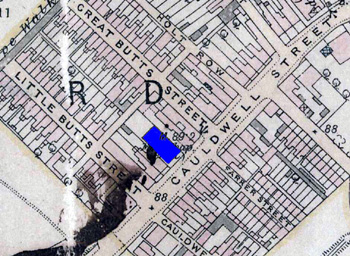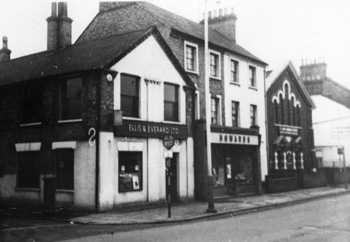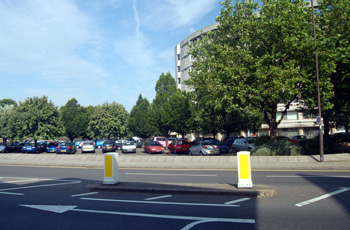Cauldwell Street Primitive Methodist Church

Cauldwell Street Baptist Church in 1862 [Z50/9/413]
The Wesleyan Methodists built a chapel in Cauldwell Street in 1864. Evidently the Primitive Methodists felt they were missing out and, in 1876, bought the still comparatively new Baptist chapel fifty yards or so to the west and on the same side of the street. The fourteen year old building changed hands for £600 [CCE2744/25].The chapel had been mortgaged by the Baptists to John Horrell for £400 of which £330 was still outstanding and the Methodist trustees continued the mortgage [CCE2744/27].
The chapel was registered with the Archdeaconry of Bedford in 1897 and in the same year a schoolroom was built [BorB/P3354]. The Primitive and Wesleyan Methodists united in 1932 to form the Methodist Church of Great Britain and by the Second World War it was evident that the church could not support two premises in Cauldwell Street, though the BBC Club Choir held two concerts at the chapel, on 5th February and 8th December 1842. A letter from the Primitive Methodist trust secretary, to the secretary of the North London District on 10th May 1944 [MB2033] tells the story.

The Primitive Methodist Chapel shown in blue on this map of 1901
“For some time past and since the amalgamation of the Bedford St. Mary’s and Cauldwell Street Circuits, the Cauldwell Street Church and the St. Mary’s Church, also situate in Cauldwell Street, have been discussing the question of unification of the two societies and, with this object in view, the Trustees of each of the Churches have been approached upon certain matters to ensure that, in the event of the Trustees themselves being agreeable to union, no difficulty would arise with regard to Church Buildings”.
The St. Mary’s Trustees have passed the following resolution –
“That as soon as convenient after cessation of hostilities, an Architect be appointed to advise on the alteration of the interior of St. Mary’s Church to provide for the removal of the stone pulpit and the construction of a rostrum, together with the possible alteration of the position of the organ, etc.”.
and the Cauldwell Street Trustees have passed the following –
“That, in order that the proposals with regard to alteration etc. of St. Mary’s Church may be proceeded with after the war, the Trustees of the Cauldwell Street Church agree to the sale of their Church and Premises and to an application being made to the Chapel Committee for permission to use the proceeds to defray the cost of the alteration to St. Mary’s Church and for any balance remaining to be utilised for the reduction of the debt on the Manse at 62, Ampthill Road, Bedford”.
“As a result, I am to enquire before negotiations proceed further whether the appropriate Connexional Committee will agree to the proposals of the Cauldwell Street Trustees with regard to the disposal of the proceeds of sale when they are actually submitted which, of course, cannot be until such time as the Cauldwell Street Church is definitely sold”.
The District secretary replied: “Thank you for your letter re the Amalgamation of the two Societies in your circuit. May I be allowed to offer my sincere congratulations. It is the kind of thing that many of us are hoping will be more common throughout the Connexion”.

The former Primitive Methodist Church about 1960 [Z50/9/284]
The chapel was sold to the Saint John’s Ambulance in 1946 for £3,000 [CCE2744/12]. The building served as the Divisional Headquarters until sold to Bedfordshire County Council in 1970, allowing the chapel to be demolished to make way for the car park of County Hall (renamed Borough Hall on 1st April 2009 on the abolition of Bedfordshire County Council).
 The site of the Primitive Methodist Church - left of shot - in July 2008
The site of the Primitive Methodist Church - left of shot - in July 2008